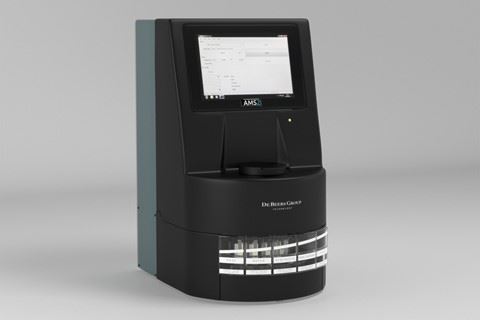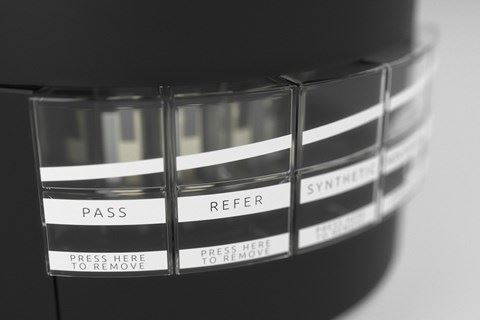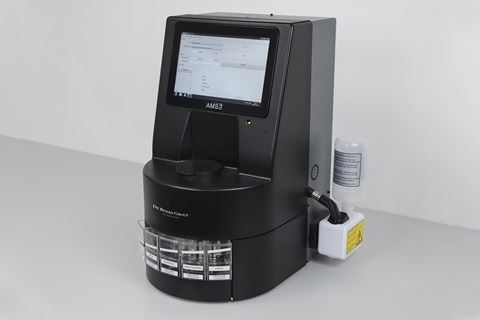Automated Melee Screening (AMS2)
The AMS2 (Automated Melee Screening) instrument from De Beers Group Industry Services represents a significant technological advance in the field of diamond melee screening.
A product of De Beers Group's world-leading expertise in diamond research, it is a revolutionary measurement technique that gives a much lower referral rate than its predecessor.
Operating at a much higher speed, the AMS2 instrument accepts a wider range of stone sizes and shapes with smaller minimum sizes, yet is available at a lower cost than the previous generation AMS device.
Around 99 per cent of colourless and near colourless stones will pass and require no further examination. The AMS2 will refer for further tests all synthetics and simulants and less than one per cent of natural diamonds. These referred stones can then be looked at on the DiamondView.
FEATURES INCLUDE:
- Automated feed and dispense.
- Low referral rate; testing for both CVD & HPHT.
- Speed: up to 3,600 stones per hour.
- Cuts: round brilliant and many fancy shapes.
- Stone size: round brilliant: 0.0032ct up to 0.2ct; fancy shapes: 0.01ct up to 0.2ct.
- Colour range: colourless/near colourless.
- Failsafe in all colour ranges.
- Fully embedded system; no external PC required.

The AMS2 instrument measures approximately 315mm(w) x 400mm(d) x 550mm(h). The machine can be located in any type of environmentally controlled facility.

Operating at a much higher speed, the AMS2 instrument accepts a wider range of stone sizes and shapes with smaller minimum sizes.

AMS2 humidifier
De Beers Technology presents the latest add-on to the AMS2 to control humidity levels.
An easy to install add-on to help control the humidity levels to lower static charge and improve performance in low humidity environments.
Support videos and User Guidance
AMS2 Frequently Asked Questions
The decision on whether a stone is diamond or non-diamond is made using a photoluminescence measurement, where we look for the presence of a Raman peak to identify diamond. This peak is visible in the spectra collected from both natural and synthetic diamonds but is not present in the spectra from simulants. This measurement is not used to determine if the stone is natural, only whether it is diamond. This measurement is taken by exposing the stone to a laser and collecting the light emitted by the stone as it is excited by the laser light. The collected light is then measured using a spectrometer and an algorithm is used to interpret the results. In around 99.9 per cent of cases, the information collected from a natural diamond is acceptable to confirm with confidence that the stone is diamond. In a very small number of stones, the information received cannot be used to state categorically that the stone is diamond and, in any such case, the stone is dispensed as non-diamond. Since the main purpose of the machine is to identify natural diamonds, clearly the most important aspect is to ensure everything that is dispensed into the pass bin is in fact natural diamond. Essentially, we have to ensure that the machine is failsafe. With this in mind, it is better to dispense a very small number of natural diamonds as non-diamond than to have any possibility that a simulant would be detected as diamond and therefore dispensed into the pass bin. Our main aim, therefore, is to ensure the integrity of the pass bin. As stated in the operator manual, the output of the refer, synthetic and non-diamond dispense bins should be further tested. There may also be the odd occasion where the stones are fed slightly out of position within the machine and may only be partially exposed to the laser light. On these occasions, a non-diamond result might be given for a natural diamond. For this reason, we have provided the facility at the end of a screening run to reset the non-diamond count and rerun these stones. See section 6.2.12 of the operator manual for further information. We recommend that all stones dispensed to non-diamond are retested with the AMS2 device at least once, since this may allow a pass result to be achieved.
The AMS2 requires the temperature and humidity levels to be within the following range:
humidity: 45-65 per cent; temperature: 15-28 degrees.
The machine monitors the humidity and temperature levels before and during a screening run and warns the user if these are not within specification. If the humidity drops below 45 per cent, the machine may not handle the stones being screened well owing to a build-up of electrostatic charge. Humidity can generally be controlled through air-conditioning.
If it is not possible to get the humidity levels within limits, an optional integrated humidifier accessory is available and can be purchased through De Beers Group Industry Services. Click here for more information.
A calibration sample is supplied with each AMS2 machine. The calibration sample is marked with the serial number of its associated AMS2 machine and the sample should be kept in a safe place. The sample should also be stored in the bag it is supplied in to ensure it is kept clean.
The calibration operation is simple and on screen instructions are displayed on the AMS2 touch screen that will guide the user through the process. Select Tools>Options>Calibration Wizard to start the process.
The AMS2 machine requires calibration every 30 days. When the current calibration has fewer than five days remaining ,the machine will notify you every time you start a screening run. A new calibration should be completed within this time. If the calibration expires, it will not be possible to use the machine until a calibration is completed.
No, only the calibration sample supplied with a machine may be used to calibrate it. The calibration sample is marked with the serial number of its associated AMS2 machine and the sample should be kept in a safe place.
The quoted feed rate of the AMS2 machine is up to 3,600 stones per hour. It is expected the machine will screen stones at a feed rate between 3,000 and 3,600 stones per hour. If the feed rate drops below this level, there are a number of factors to consider:
- Are the environmental limits met? If the humidity is below 45 per cent, the machine may experience a build-up of static electricity charge which can cause the diamonds to feed poorly.
- Are the stones clean? If the diamonds being screened are dirty or greasy, this is likely to cause the machine to feed poorly and the feed rate will reduce.
- Is the machine clean? Dirt and dust build-up on the disc and guide surfaces of the machine may cause the diamonds to feed poorly. It is recommended to clean the machine before every screening. See section 6.3.7.1 of the operator manual.
- At the start of a screening run, the feed rate will be lower while the machine’s stone handling systems fill with stones. Similarly, towards the end of a screening run, the feed rate will diminish as the handling systems are starved of stones.
- Small parcels may have insufficient stones to allow the quoted feed rate to be achieved.
Following the initial screening results, it is possible to reset the counts of both the Refer and Non-Diamond outputs. These stones can then be retested as it is possible to achieve a pass result following a second test. See sections 6.2.11 and 6.2.12 of the operator manual. We recommend all stones dispensed to Refer and Non-Diamond are retested with the AMS2 device at least once, as a pass result may be achieved on a retest.
There are two ways to start the AMS2 machine: pressing the Start button will complete a Normal start; pressing and holding the Start button will allow the user to select either a Normal or a Fast Start.
A Fast start is optional. This will cause the first stone to be screened more quickly than if a normal start had been selected. When using the touch-screen, pressing the Start button for a second or two will present a menu giving the user the option of a Normal or Fast start. If an external user-supplied mouse is being used, the same effect may be achieved by right-clicking on the Start button.
The Fast start option should not be selected unless the machine is known to be empty. If more than one Fast start is made for a given parcel of goods in the hopper, the machine is likely to become flooded with goods.
The Fast start will not cause the feed rate for the machine to be increased; it simply allows the first stone to be measured more quickly.
If the stones being screened are smaller than stone size that has been selected, the machine will run more slowly than normal; if the stones being screened are larger than the stone size selected, the machine may become flooded with stones.
Depending on the actual size difference, an increased number of stones may be automatically recycled within the machine and may remain unmeasured at the end of a screening run.
A powered USB hub can be safely used with the instrument. A non-powered hub can cause the instrument not to function correctly and in extreme cases can cause damage.
No, treated stones cannot be screened on AMS2.